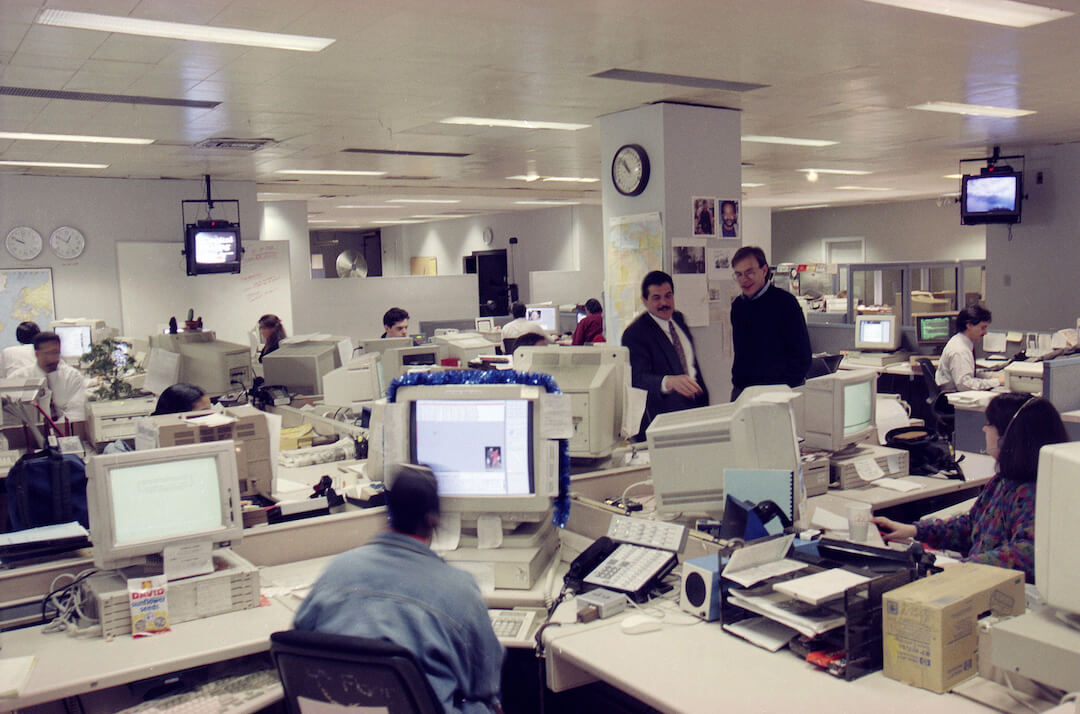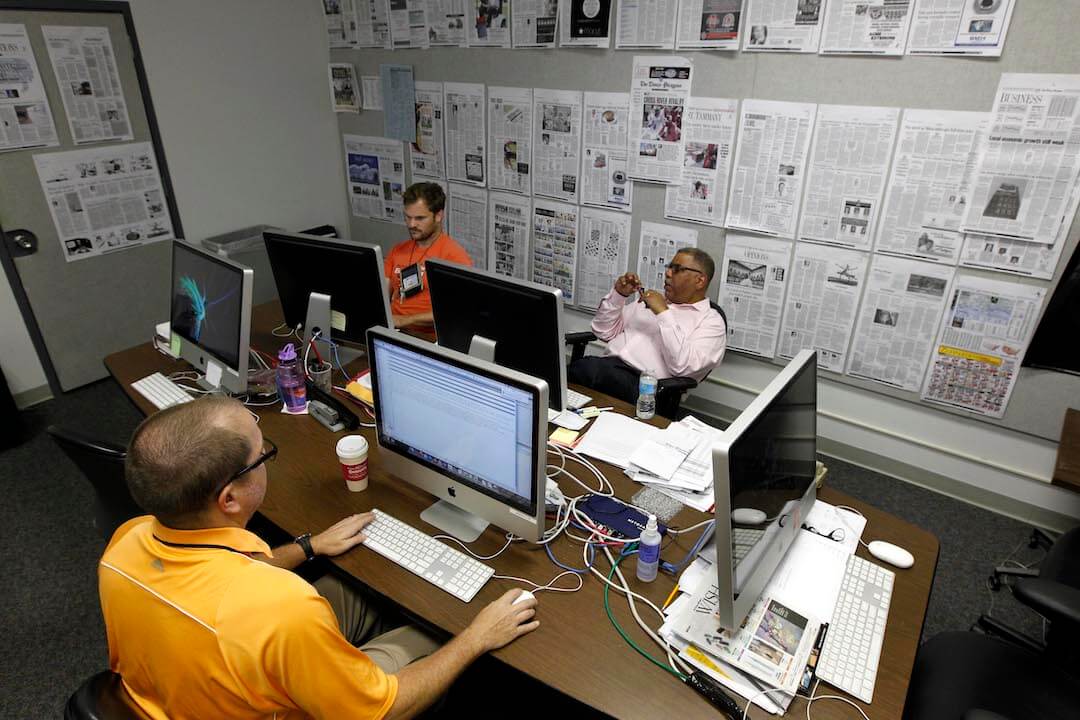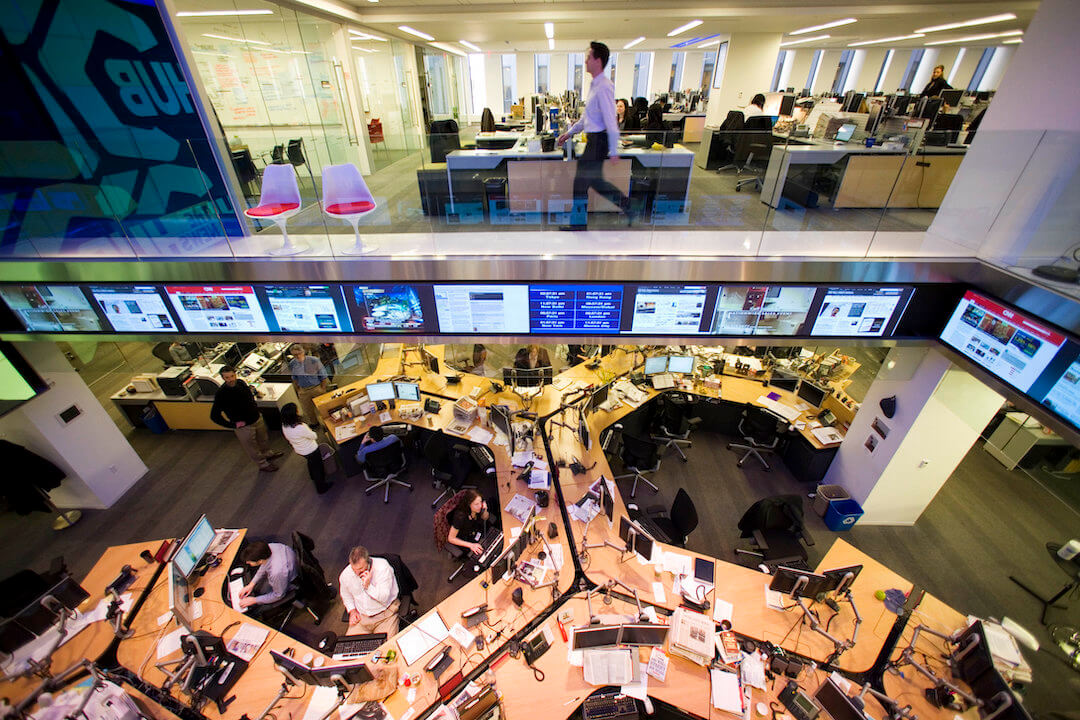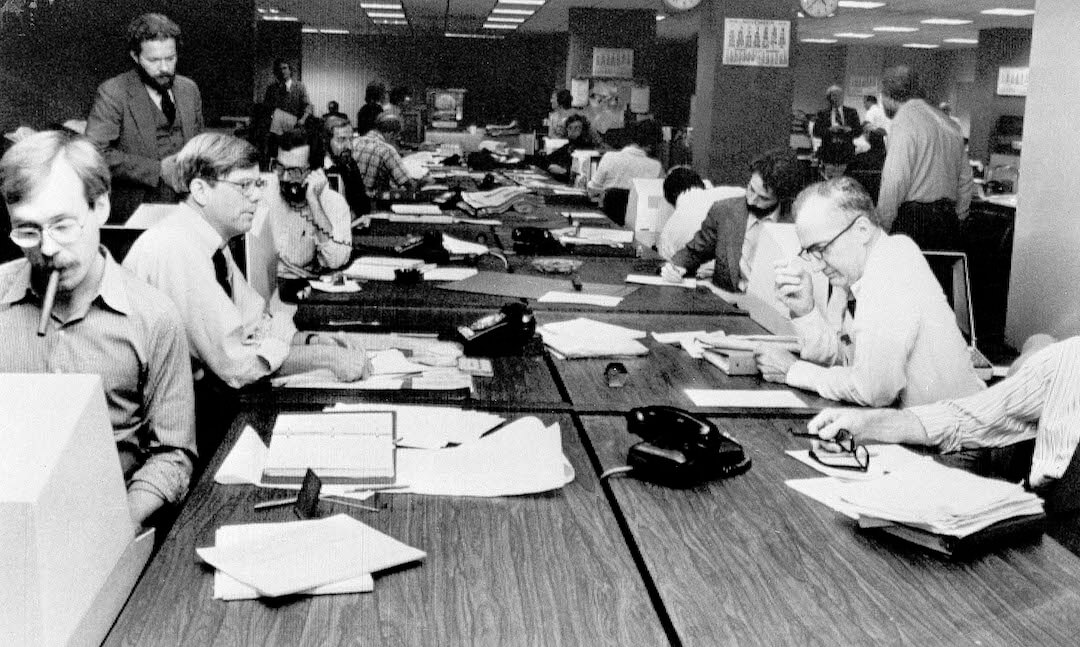This article was originally published on Northwestern University’s Medill Local News Initiative website and is republished here with permission.
The classic newspaper newsroom maintains a powerful mystique among journalists and nonjournalists alike. You need not have set foot in one to conjure up vivid images of reporters working the phones, banging on typewriters or computer keyboards, smoking cigarettes (in the olden days) or chugging coffee and barking at colleagues while trying to nail down The Story.
The grit, hard work and ink-stained glamor are tangible in movies such as “The Front Page” (originally a play), “His Girl Friday” (originally “The Front Page”) and “Calling Northside 777” through “All the President’s Men,” “Spotlight” and “She Said,” as well as Aaron Sorkin’s short-lived HBO series about a cable news network titled, yes, “The Newsroom.”
Even if real-life newsrooms aren’t as rife with drama as their on-screen counterparts, these workplaces remain distinct in the way they gather reporters, editors, photographers, designers and more to produce the news on tight deadlines. This is pressurized work done collectively (multiple departments must collaborate to create timely reports) and individually (there’s nothing between you and that blank page or screen when the story must get written). The newsroom is where it happens.
Or happened.
Through a combination of technological advances, economic conditions, workforce reductions and a pandemic that has conditioned many people to work at home, the newsroom is a changed, often-diminished setting. Some companies have sold their buildings and relocated, downsized and/or eliminated their newsrooms. Some have set up hybrid workplaces where staffers sometimes come in and sometimes work remotely, with meetings routinely conducted over Slack, Zoom or some other virtual host. Some newsrooms exist as co-working spaces where reporters no longer have assigned desks. Some outlets no longer have newsrooms at all.
Many journalists lament the loss of the old-school newsroom in ways that may be as sentimental as practical. The more pressing question is whether and how these newsroom changes are affecting journalism itself. Does the loss or diminishment of a newsroom translate to a loss or diminishment in reporting and editing?
“I think people tend not to understand just how valuable it can be,” retired Washington Post executive editor Marty Baron said of the physical newsroom. “It creates a sense of teamwork. People know each other. Young people develop professional networks that way that are going to be hugely valuable to them over the course of their careers. If somebody wants to get promoted, it’s really important that their superiors within a newsroom know them as human beings, not just as faces on a screen — that they see how they interact with other people, how they manage themselves in meetings. And Zoom meetings are not the same sort of meetings.”
Nikki Usher, a University of San Diego communication studies associate professor and author of the 2021 book “News for the Rich, White and Blue: What the Decline of Journalism Means for America,” said in theory the newsroom should not play a major role in the pursuit of journalism.
“On one level reporters and photographers shouldn’t be in newsrooms because they should be out reporting, right?” Usher said, noting that some reporters traditionally work out of City Hall, the State House or police headquarters. “Some beats have never really been located in newsrooms, and they have continued on just fine. Good journalists should not necessarily need newsrooms to do their journalism.”
But at the same time, Usher added, journalism is often better amid collaboration. “Things happen in person that don’t happen for most people when they’re chatting on Slack,” they say. “You talk through stories and angles and sources. The regular conversations that you might have, you’re not having.”
The location of the newsroom — and the commute to get there — may be as significant as the newsroom itself, Usher said. Some journalists may live in upscale neighborhoods and would experience a wide swath of the city by passing through other neighborhoods to arrive at a newsroom often located in the urban center — though as companies have cashed in on their real estate, some newsrooms have moved away from the action.
“If you’re never being forced to leave your upwardly mobile place, are you really out and about in the city?” Usher asked. “When people aren’t leaving their neighborhoods, that creates a myopia about the issues that matter to cities and counties at large. The Washington Post always runs these leaf-blower stories in the fall. … If you’re a journalist in a leaf-blower neighborhood, you should make sure you get some time in a neighborhood where they don’t have leaf blowers.”
Newsroom’s ‘obituary’?

A general view of the photo department at the Associated Press in New York, seen Feb. 9, 1994. (AP Photo/Marty Lederhandler)
In April, New York Times columnist Maureen Dowd wrote her “final obituary for the American newspaper newsroom,” noting: “As I write this, I’m in a deserted newsroom in The Times’s D.C. office. After working at home for two years during COVID, I was elated to get back, so I could wander around and pick up the latest scoop. But in the last year, there has been only a smattering of people whenever I’m here, with row upon row of empty desks.”
She lamented that the Times union had made remote work “a major priority,” wanting its members to be required to appear in the building no more than twice a week in 2023 and three times a week in 2024. In May, the paper and Times Guild agreed to a contract in which editorial workers would return to the office three days a week through Sept. 2, 2024, at which point management could increase the commitment to four days a week, though it has not announced its intention to do so. Axios reported in late August that two Times unions sent cease-and-desist letters to management to protest the paper’s intention to monitor attendance through employees’ badge swipes.
“I’m mystified when I hear that so many of our 20-something news assistants prefer to work from home,” Dowd wrote. “At that age, I would have had a hard time finding mentors or friends or boyfriends if I hadn’t been in the newsroom, and I never could have latched onto so many breaking stories if I hadn’t raised my hand and said, ‘I’ll go.’”
Gabby Jimenez has no such memories because she’s 20 years old, a last-semester senior at Louisiana State University and, since August, a police reporter for the Advocate, Louisiana’s largest daily newspaper. But she sees the value of the newsroom. Covering breaking news 10 a.m. to 8 p.m. on Sundays and 5 to 10 p.m. Mondays through Thursdays in “a hybrid job,” Jimenez says she tries to work out of the Baton Rouge office “at least three days a week” — usually those weeknights when other editors and reporters are present.
“I don’t come in on Sundays because no one’s really in the office on Sundays,” she says. “I want to interact with my coworkers.”
Although editors have fixed desks in the newsroom, reporters “sit and work anywhere,” Jimenez said, with areas designated for the metro and digital departments. She’s more likely to work from home when she’s reporting a story closer to where she lives.
“I love the newsroom, honestly,” she says. “There’s a lot of interaction going on even if it’s not about work. It’s nice to talk to people and talk about their day. I don’t like when it gets impersonal, just seeing someone over their Slack profile. I like knowing the people I work with.”
Aside from building camaraderie, these interactions spur stories, such as when she mentioned to her editor that she’d eaten at a Baton Rouge restaurant that she learned was closing. A San Antonio native, Jimenez didn’t realize this was a beloved local restaurant, so her editor alerted the features editor, who assigned a story.
Such productive interactions can’t be measured. Likewise, no one keeps tabs on the reduction in efficiency and increase in tension when an editor, instead of approaching a reporter’s desk to ask someone to cover a story, must send out emails and texts and then wait for a response. These exchanges can get drawn out as emailing “no” may feel more fraught than explaining how busy you are in a casual conversation.
“We have tended to devalue human contact, and I think that’s a huge mistake,” Baron said. “There are always huge misunderstandings when you’re communicating by email or by Slack or in Zoom meetings or what have you.”
‘A flexible approach’

The New Orleans Times-Picayune’s office in New Orleans, on Thursday, Sept. 27, 2012. (AP Photo/Gerald Herbert)
The Sacramento, California-based McClatchy chain, which operates 29 daily newspapers in 14 states, offers a snapshot of the state of its newsrooms. The company is taking “a flexible approach,” Robyn Tomlin, McClatchy’s chief news officer, said in an email.
“About half of our newsrooms are in dedicated newsroom office space and most of the rest use some kind of co-working space,” Tomlin wrote. “There are just a few small teams that are completely remote, but even in those cases, we often make arrangements for them to work together in some kind of shared space on a regular basis.”
As has been the case with many newspapers, the pandemic spurred change for McClatchy — and not just on the health side. “We went through bankruptcy during COVID, which gave us the opportunity to get out of some leases for spaces that no longer fit our needs,” Tomlin said. “So we shut down a lot of newsrooms during the period, but we’ve since worked (and continue to work) to find the best solutions for each one.”
Tomlin offered examples:
- “The News & Observer in Raleigh is in the same downtown space, but during lease renewal, we had the space cut down a bit to better suit our needs.”
- “The Miami Herald is in a new space they just moved into two weeks ago after being mostly remote for the last few years.”
- “The Sacramento Bee, The State in Columbia, South Carolina and several others are in newer spaces that have opened post-COVID.”
- “The Charlotte Observer, Myrtle Beach Sun News and others are in shared or co-working spaces.”
- “Our D.C. bureau, which mostly works out of the Capitol and White House press rooms, is fully remote.”
- “The Rock Hill Herald is remote, but they work one day a week out of a coffee shop that they have a deal with. They can also use the Charlotte Observer’s co-working space as needed.”
Tomlin wrote: “Fundamentally, we believe that our local teams need time and space together to collaborate, plan, talk about new ideas, learn from one another and celebrate successes. But that doesn’t mean it has to be a traditional newsroom space with a cubicle for every person. After all that we’ve learned over the last few years, there’s no reason to force people to work in an office 9-5 when we know that flexibility works better for most people.”
She adds that she recently visited the Miami Herald, “where they have opened a new newsroom after being mostly remote (they had a small collab space) for the last few years. The new office is a flexible space in a terrific location with access to lots of conference and meeting areas. It was great seeing the team gather and reconnect and start figuring out some new rhythms.”
In response to a request about the state of its newsrooms, Gannett — the country’s largest newspaper publisher as owner of USA Today, the Detroit Free Press, Arizona Republic, Cincinnati Enquirer and dozens of other publications — offered this response through its corporate communications office: “We will not be sharing newsroom specific data. As you are aware, Gannett has implemented a flexible workplace model for our local newsrooms. Some staff are working remote at the discretion of our local editorial leaders. We remain committed to serving our readers and advertisers across the USA TODAY Network.”
Making way for a casino

The Philadelphia Inquirer newsroom is shown on Monday Feb. 23, 2009, in Philadelphia. (AP Photo/ Joseph Kaczmarek)
Veteran Chicago Tribune columnist Rick Kogan has experienced his share of workplace changes, having hung around newsrooms for 60 years, starting in 1963 when his father, Herman Kogan, was the editor of the Chicago Daily News’ Panorama section. Rick Kogan started at the Daily News himself in 1977, and when that paper folded the following year, he walked down the hall in the same building to work at the Chicago Sun-Times. He has been on the Tribune’s staff since 1989 and doesn’t know where his desk will be next summer.
“I don’t know what if any newsroom we’re going to have after this so-called newsroom,” Kogan says.
“This so-called newsroom” is the Tribune’s editorial offices in the paper’s printing plant building, known as Freedom Center, in Chicago’s River West neighborhood. The newsroom moved there after vacating its larger space in 2021 in the downtown Prudential Plaza, which it had occupied since 2018. The Tribune previously was based in Tribune Tower on North Michigan Avenue for 93 years before the parent company was divided post-bankruptcy, and Tribune Publishing and the company’s real estate went separate ways.
(Disclosure: I was a Tribune staff reporter for more than 23 years, leaving before the paper moved out of Tribune Tower.)
Now Bally’s Chicago Casino has bought the Freedom Center real estate to build the city’s first casino, and Tribune Publishing agreed in May to leave the space by July 2024. Also in May the company announced that it was buying the northwest suburban Daily Herald’s printing plant in Schaumburg, but it has yet to reveal plans for a relocated newsroom. Tribune officials declined comment.
Kogan says he has set foot in the Tribune newsroom maybe twice since it moved to Freedom Center. “It’s not a newsroom in the sense of how I’ve known newsrooms,” he said. “It hasn’t been for a long time.”
He wasn’t a fan of the setup in Prudential Plaza either, with reporters clustered “in this pod-like setup that was supposed to foster communication. I thought whoever fell for that design is a (expletive) idiot.”
But even the Tribune Tower newsroom had issues, he says, though the biggest ones had little to do with the physical layout. “The newsroom of my youth was a loud, frenetic environment,” Kogan said. “The real change in newsrooms came when computers came because they enabled some lazy reporters to never leave the office. The nature of newsroom communication has been absolutely dulled and silenced almost by computers. This sounds like an old fart saying this, but I absolutely believe it to be true. I think it made people even more insular, and the Tribune was always an insular place.”
In earlier days, Kogan said, reporters could pick the brains of, for instance, Daily News reporter Bill (M.W.) Newman and columnist Mike Royko about City Hall’s inner workings and other topics. “That’s where I learned most of what I know, not from the internet but from mining the intelligence and experience of colleagues,” Kogan said. “If you had time, you didn’t spend it flipping around the internet looking at baseball scores.”
Full circle

The news hub of the Wall Street Journal, on Wednesday, March 24, 2010, in New York. (AP Photo/Mark Lennihan)
William Mari, an LSU media law assistant professor and author of “The American Newsroom: A History, 1920-1960” and “Newsrooms and the Disruption of the Internet: A Short History of Disruptive Technologies, 1990-2010,” says in a way newsrooms have come full circle. Ben Franklin and his colleagues worked out of people’s houses on the Pennsylvania Gazette, his newspaper published from 1728 through 1800. Even through the 1800s, newsrooms remained small, populated more by editors than reporters. Large newsrooms didn’t come into fashion early in the 20th century, when editorial offices and production facilities tended to coexist under one big roof.
“That’s the heyday of big newsroom spaces,” Mari said, referring to the period between World War I and the end of the Cold War. “It was pretty common to work in a large news-producing facility for a long time. That was a unique moment in history.”
Many of these newspaper buildings were designed to amplify the institutions’ importance in society. Joseph Pulitzer’s New York World building, completed in 1890, was New York’s tallest building at the time. The neo-gothic Tribune Tower, finished in 1925 and overlooking the Chicago River, was the culmination of a high-profile international architectural competition. The 36-story art deco New York Daily News building, designed by Tribune Tower architect Raymond Hood, opened in 1930 on 42nd Street in Manhattan.
The World building since has been demolished, while Tribune and Daily News no longer reside in their namesake buildings. Many other newspapers, including the Los Angeles Times and The Washington Post, have moved out of their prominent, longtime headquarters as well.
“Journalists are nostalgic people, and they’ve always been nostalgic,” Mari said. “In the early 20th century, they were complaining about these large industrial spaces with harsh lights. Before that they were complaining about electric lights.” The introduction of carpeting also stirred controversy. “Every generation has nostalgia for the last newsrooms they were in.”
Even the so-called good old days weren’t good for everyone. Mari noted that for many years, newsrooms may have felt comfortable for white men with thick skins but could be “a rough place” for anyone else. It wasn’t until the tail end of the previous century that newsrooms became more welcoming and diverse, and even that was a work in progress.
“There are definitely some things that are not sad about the old newsrooms disappearing,” Mari said. “If you’re going to be nostalgic for any newsroom, it would be the late 20th-century newsroom.”
Since then, staff sizes have been slashed; newspaper companies have filed for bankruptcy protection, merged and/or been swallowed by hedge funds intent on squeezing out every last dollar for its shareholders; real estate has been cashed in; news deserts have grown; and fewer reporters experience the bustling energy of a robust newsroom.
“The question for the next generation of journalists is which traditions will continue, and which will go away?” Mari asked.
Jimenez says she appreciates being able to work out of her Baton Rouge newsroom, even if it’s not like what she has seen in the movies. For one, she says, her laptop is her office, so she really can work anywhere, even as she appreciates the benefit of gathering in person with colleagues.
“When you watch ‘All the President’s Men,’ they all look very intent, and their desks are stacked with papers,” Jimenez says. “It’s not like that anymore.”







